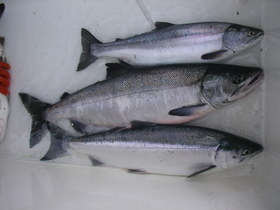A bill that would continue and expand Alaska’s tax credit for seafood processors installing new equipment had support from the Parnell administration and the industry before the House fisheries committee Thursday. Supporters said the legislation could help companies get more value out of the salmon and herring caught around the state.
For mobile-friendly audio, click here:
House bill 204 is sponsored by Alan Austerman of Kodiak. Peggy Wilson of Wrangell is a co-sponsor. It would extend a seafood processing tax credit beyond 2015 and would add processing machines for herring to the list of new equipment that qualifies a processor for the tax credit. It would also add equipment for putting salmon in cans, different from the tall or short cans traditionally used by industry.
Joe Jacobson, director of the state’s division of Economic Development, told the committee the administration supported the measure. He said the tax credit promotes innovation in creating new seafood products and that diversification helped weather price fluctuations. “You know if you’re going to many different countries and you have salmon burgers, you have canned salmon, you have salmon jerky, it just supports the price so that when one market of canned salmon dies, well now you have a fillet market in the US, or you have a roe market in Japan or the Ukraine or other places,” Jacobson said. “And it just kind of lessens the impact of individual markets that may go up or down because you’re just building a broader portfolio of products that are spread out.” Jacobson said current can sizes are out of touch with markets and consumers need smaller sizes of canned fish.

The bill would also provide the tax credit to companies installing equipment for making a product out of fish scraps and waste. That was an important addition for Trident Seafood’s Joe Plesha. “You know one of the best ways to add value to Alaska’s resources is obviously to produce a product from something that’s now being ground up and discharged back into the water.” Plesha noted the Environmental Protection Agency could start requiring some shore based processing plants in Alaska to screen out the solid fish scraps from waste before its pumped out into the water, or even barge the waste to the open ocean.
Another industry representative, Tom Sunderland, vice president of marketing with Ocean Beauty Seafoods, said the tax credit has worked and he agreed the market is calling for smaller sizes of canned fish. “This allows us to respond to the market pressure which is a really big deal, we have to have it. Our customers are now expressing pretty urgent resistance to the prices that are necessitated by the current size of the can.”
Others testifying at the hearing also liked the inclusion of herring for the tax credit. The Alaska Seafood Marketing Institute international global food aid director Bruce Schactler said herring was a big business elsewhere. “You can go over to Germany and places in Europe and you can see a display twice as long as this room on one wall that is nothing but herring products. So we got to thinking why not, and why not us. How about if we use the males?” Herring are caught in some fisheries in Alaska for their roe, so only female egg bearing fish are valuable on international markets.
Julianne Curry of the industry group United Fisherman of Alaska also testified in support of the legislation.
:12 “This bill allows the processing sector to really encourage innovation within the processing sector and it also allows the processing sector to provide incentives to respond to changing market demands.”
That measure was held in the fisheries committee for another hearing. That second hearing is scheduled for February 13th.









